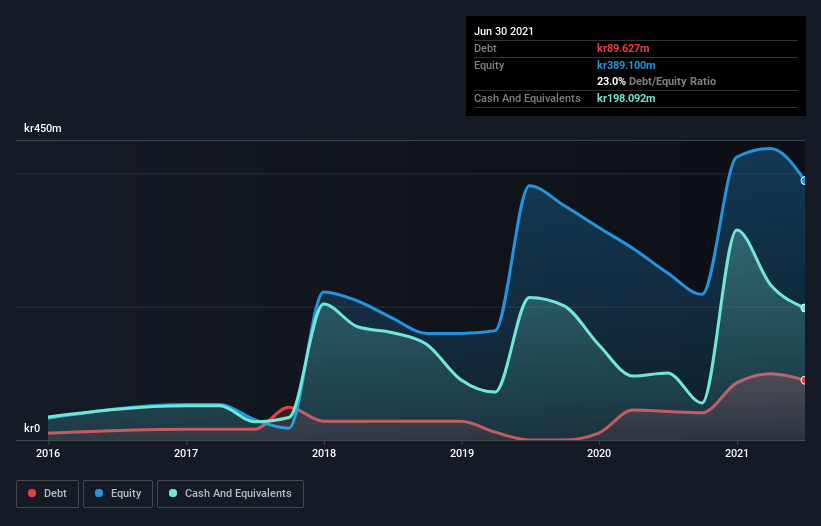
Some say volatility, rather than debt, is the best way to think about risk as an investor, but Warren Buffett famously said that 'Volatility is far from synonymous with risk.' So it seems the smart money knows that debt - which is usually involved in bankruptcies - is a very important factor, when you assess how risky a company is. We can see that Climeon AB (publ) (STO:CLIME B) does use debt in its business. But is this debt a concern to shareholders?
When Is Debt Dangerous?
Debt and other liabilities become risky for a business when it cannot easily fulfill those obligations, either with free cash flow or by raising capital at an attractive price. Ultimately, if the company can't fulfill its legal obligations to repay debt, shareholders could walk away with nothing. However, a more usual (but still expensive) situation is where a company must dilute shareholders at a cheap share price simply to get debt under control. By replacing dilution, though, debt can be an extremely good tool for businesses that need capital to invest in growth at high rates of return. The first thing to do when considering how much debt a business uses is to look at its cash and debt together.
See our latest analysis for Climeon
How Much Debt Does Climeon Carry?
The image below, which you can click on for greater detail, shows that at June 2021 Climeon had debt of kr89.6m, up from kr42.7m in one year. But on the other hand it also has kr198.1m in cash, leading to a kr108.5m net cash position.

How Strong Is Climeon's Balance Sheet?
According to the last reported balance sheet, Climeon had liabilities of kr132.7m due within 12 months, and liabilities of kr89.6m due beyond 12 months. On the other hand, it had cash of kr198.1m and kr89.7m worth of receivables due within a year. So it can boast kr65.5m more liquid assets than total liabilities.
This short term liquidity is a sign that Climeon could probably pay off its debt with ease, as its balance sheet is far from stretched. Succinctly put, Climeon boasts net cash, so it's fair to say it does not have a heavy debt load! The balance sheet is clearly the area to focus on when you are analysing debt. But it is future earnings, more than anything, that will determine Climeon's ability to maintain a healthy balance sheet going forward. So if you want to see what the professionals think, you might find this free report on analyst profit forecasts to be interesting.
Over 12 months, Climeon made a loss at the EBIT level, and saw its revenue drop to kr71m, which is a fall of 48%. To be frank that doesn't bode well.
So How Risky Is Climeon?
We have no doubt that loss making companies are, in general, riskier than profitable ones. And the fact is that over the last twelve months Climeon lost money at the earnings before interest and tax (EBIT) line. And over the same period it saw negative free cash outflow of kr206m and booked a kr107m accounting loss. Given it only has net cash of kr108.5m, the company may need to raise more capital if it doesn't reach break-even soon. Overall, its balance sheet doesn't seem overly risky, at the moment, but we're always cautious until we see the positive free cash flow. There's no doubt that we learn most about debt from the balance sheet. However, not all investment risk resides within the balance sheet - far from it. To that end, you should learn about the 4 warning signs we've spotted with Climeon (including 1 which doesn't sit too well with us) .
If you're interested in investing in businesses that can grow profits without the burden of debt, then check out this free list of growing businesses that have net cash on the balance sheet.
If you're looking to trade Climeon, open an account with the lowest-cost platform trusted by professionals, Interactive Brokers.
With clients in over 200 countries and territories, and access to 160 markets, IBKR lets you trade stocks, options, futures, forex, bonds and funds from a single integrated account.
Enjoy no hidden fees, no account minimums, and FX conversion rates as low as 0.03%, far better than what most brokers offer.
Sponsored ContentNew: AI Stock Screener & Alerts
Our new AI Stock Screener scans the market every day to uncover opportunities.
• Dividend Powerhouses (3%+ Yield)
• Undervalued Small Caps with Insider Buying
• High growth Tech and AI Companies
Or build your own from over 50 metrics.
This article by Simply Wall St is general in nature. We provide commentary based on historical data and analyst forecasts only using an unbiased methodology and our articles are not intended to be financial advice. It does not constitute a recommendation to buy or sell any stock, and does not take account of your objectives, or your financial situation. We aim to bring you long-term focused analysis driven by fundamental data. Note that our analysis may not factor in the latest price-sensitive company announcements or qualitative material. Simply Wall St has no position in any stocks mentioned.
Have feedback on this article? Concerned about the content? Get in touch with us directly. Alternatively, email editorial-team (at) simplywallst.com.
About OM:CLIME B
Medium-low with adequate balance sheet.
Similar Companies
Market Insights
Community Narratives



